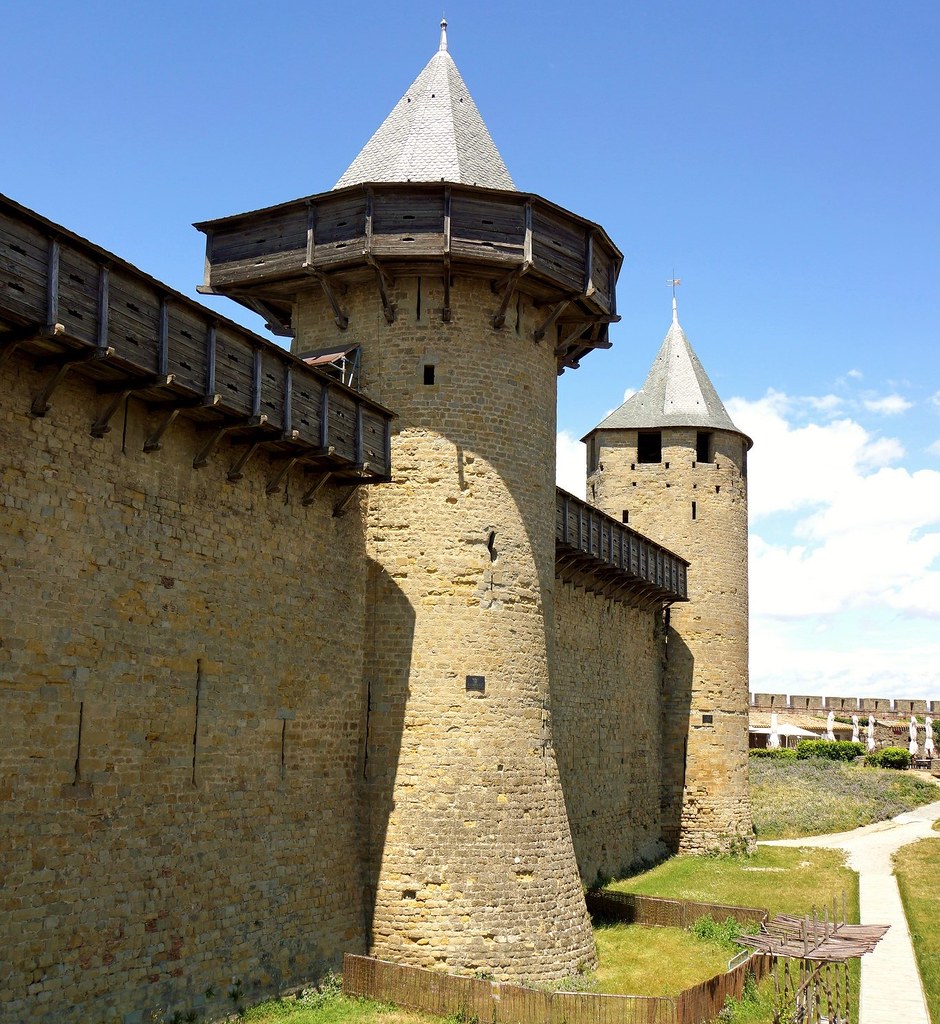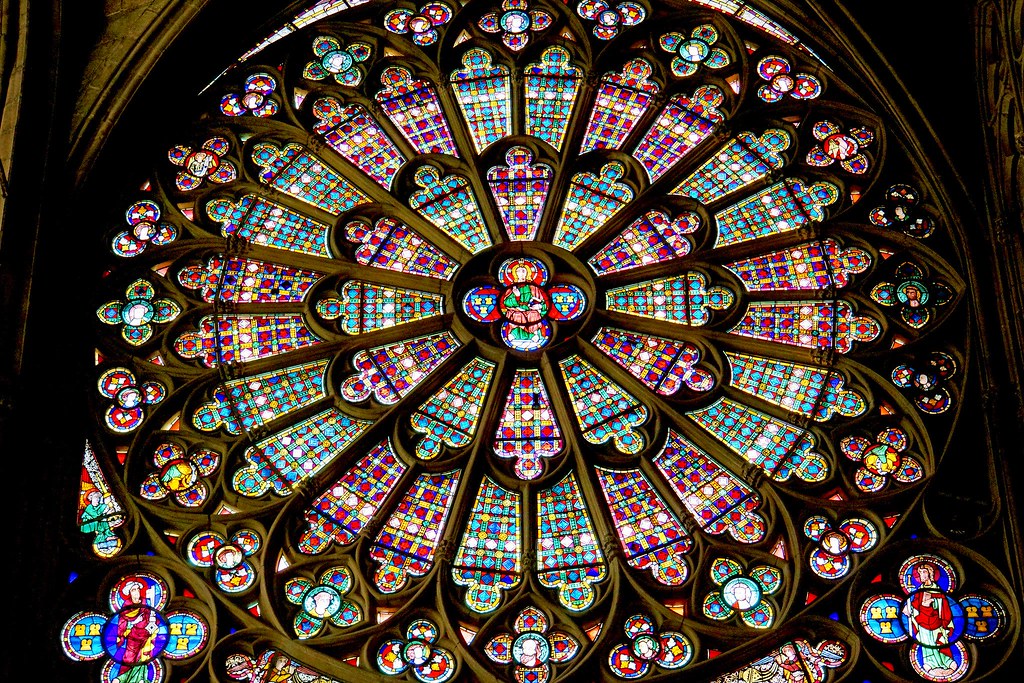
Slate roofs glint in the sun atop 13th-century towers that dominate the horizon.
Surrounded by mountains and vineyards, the scent of pine shrubs, spicy herbs, and sweet flowers is carried on the cool winds. Known as the garrigue (gah-REEG), it is the signature scent of the south of France.
 View of the medieval city of Carcassonne amongst vineyards. Photo Harry. Photo Dennis Jarvis
View of the medieval city of Carcassonne amongst vineyards. Photo Harry. Photo Dennis JarvisHere are 10 amazing facts about this medieval wonder that you might not know.
1. The walls of the city are 1.9 miles (3 km) long
 Cité de Carcassonne. Photo erjk.amerjka
Cité de Carcassonne. Photo erjk.amerjka
 Cité de Carcassonne. Photo erjk.amerjka
Cité de Carcassonne. Photo erjk.amerjka Aerial view of Carcassonne. Credit Chensiyuan
Aerial view of Carcassonne. Credit Chensiyuan The Walls of Carcassonne. Photo Vicente Villamón
The Walls of Carcassonne. Photo Vicente Villamón2. The city walls have 52 massive towers
 Towering above. Photo candi…
Towering above. Photo candi…The fortified city has a concentric design having two outer walls with 52 towers and barbicans, designed to prevent attack by siege engines.
 The shining turrets of Carcassonne. Photo Ad Meskens
The shining turrets of Carcassonne. Photo Ad Meskens3. A Roman tower housed the Medieval Inquisition
The shallow-pitch terracotta tile roofs and red brick layers identify these towers as Roman, one of which is called “The Inquisition Tower”.
The Medieval Inquisition’s purpose was to root out and prevent the spread of Cathars and Waldensians—followers of religious movements that were denounced by the Catholic Church.
 Gallo-Roman Towers of Carcassonne.
Gallo-Roman Towers of Carcassonne. Extracts from a letter written around 1285 by the Consuls of Carcassonne to Jean Galand, a Dominican Inquisitor at Carcassonne, describe what conditions were like in the Inquisition Tower:

La Délivrance des emmurés de Carcassonne by Jean-Paul Laurens, 1879
… you have created a prison called “The Wall”, which would be better called “Hell”. In it you have constructed small cells to inflict pain and to mistreat people using various types of torture. Some prisoners remain in fetters … and are unable to move. They excrete and urinate where they are … Some are placed on the chevelet [an instrument of torture]; many of them have lost the use of their limbs because of the severity of the torture … Life for them is an agony, and death a relief. Under these constraints they affirm as true what is false, preferring to die once than to be thus tortured multiple times.
4. Carcassonne was the first fortress to use hoardings in times of siege
Overhanging wooden ramparts attached to the upper walls of the fortress provided protection to defenders on the wall and allowed them to shoot arrows or drop projectiles on attackers beneath.

… you have created a prison called “The Wall”, which would be better called “Hell”. In it you have constructed small cells to inflict pain and to mistreat people using various types of torture. Some prisoners remain in fetters … and are unable to move. They excrete and urinate where they are … Some are placed on the chevelet [an instrument of torture]; many of them have lost the use of their limbs because of the severity of the torture … Life for them is an agony, and death a relief. Under these constraints they affirm as true what is false, preferring to die once than to be thus tortured multiple times.
4. Carcassonne was the first fortress to use hoardings in times of siege
Overhanging wooden ramparts attached to the upper walls of the fortress provided protection to defenders on the wall and allowed them to shoot arrows or drop projectiles on attackers beneath.

Two of the towers that are on the right side of the entrance. Photo Dennis Jarvis

A view of eh wooden hoarding from inside the castle walls. Photo Dennis Jarvis
5. Edward the Black Prince failed to take the city during the Hundred Years’ War
During the 1355 Great Raid by the English in the Aquitaine–Languedoc region, Edward “the Black Prince” crippled southern France’s economy through the practice of chevauchée. This involved burning and pillaging enemy territory to reduce the region’s productivity.
When the Black Prince passed through Carcassonne, his army razed the Lower Town, but couldn’t take the extremely well defended walled city.
Carcassone’s position as a key defensive fortification on the border with Spain remained until the Treaty of the Pyrenees was signed, which effectively pushed the border further south—diminishing Carcassone’s strategic importance.
 The 16-year-old Black Prince at the Battle of Crecy by Julian Russel, 1888
The 16-year-old Black Prince at the Battle of Crecy by Julian Russel, 18886. In 1849, the City of Carcassonne was nearly demolished
Not the news this Carcassonne gargoyle wanted to hear.
Carcassonne was struck off the roster of official fortifications under Napoleon and the Restoration.
It fell into such disrepair that the French government decided that it should be demolished, causing an uproar among local citizens.

Mayor of Carcassonne, Jean-Pierre Cros-Mayrevieille, and writer Prosper Mérimée, inspector of ancient monuments, led a successful campaign to preserve the walled city.
The architect Eugène Viollet-le-Duc was commissioned to renovate the entire city.
 Carcassonne. Photo Vicente Villamón
Carcassonne. Photo Vicente Villamón7. The French poet Gustave Nadaud made Carcassonne famous
 Cité de Carcassonne. Photo Javier Medina
Cité de Carcassonne. Photo Javier MedinaHe wrote a poem about a man who dreamed of seeing Carcassonne before he died. His poem inspired many others and was translated into English several times.
I’m growing old, I’ve sixty years;
I’ve labored all my life in vain:
In all that time of hopes and fears
I’ve failed my dearest wish to gain.
I see full well that here below
Bliss unalloyed there is for none.
My prayer will ne’er fulfilment know
I never have seen Carcassonne,
I never have seen Carcassonne!
Read the entire poem here.
8. In 1898, Pope Leo XIII upgraded Carcassonne’s Gothic Church to a Basilica
The minor Basilica is entirely inside the city walls. Famed for its stained glass windows—some of the oldest in the south of France—the Basilica of Saints Nazarius and Celsus is a national monument.
 Basilica of Saint-Nazaire (11th – 14th century), the jewel of this medieval city, Carcassonne.
Basilica of Saint-Nazaire (11th – 14th century), the jewel of this medieval city, Carcassonne. Basilica of Saint-Nazaire is noted for its stained glass windows. Photo Dennis Jarvis
Basilica of Saint-Nazaire is noted for its stained glass windows. Photo Dennis Jarvis9. Today, there are 50 permanent residence households living within the ancient city walls
If you’d like to stay a night or two, L’Echappee Belle Bed and Breakfast is inside the ancient city walls. Owner Jacqui Boulter says most visitors aren’t aware that people actually live inside and tend to think it’s purely a tourist attraction.
Have a look around inside the walled city with this Google Maps “street view”.
10. Carcassonne competes with Mont St Michel for the title of the most visited monument in France
The citadel was restored at the end of the 19th century and in 1997 it was added to UNESCO’s list of World Heritage Sites.
 Carcassonne Castle. Photo BrianRS1
Carcassonne Castle. Photo BrianRS1 Carcassonne bridge. Photo App1990
Carcassonne bridge. Photo App1990 Carcassonne. Photo Rhino Neal
Carcassonne. Photo Rhino Neal



















